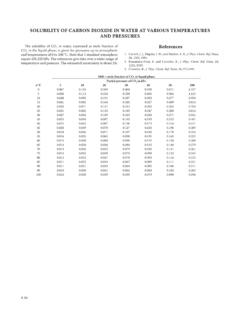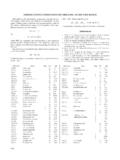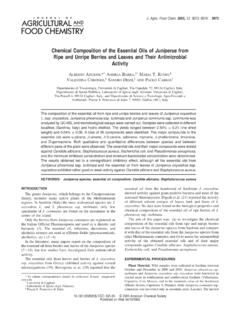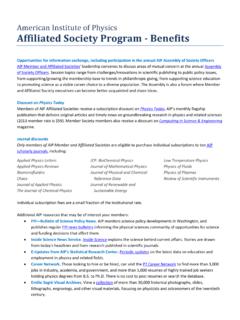Transcription of Molecular jet study of solvation of pyrazine by small ...
1 Molecular jet study of solvation of pyrazine by small hydrocarbonsJ. Wanna and E. R. BernsteinCitation: The Journal of Chemical physics 84, 927 (1986); doi: online: Table of Contents: by the american institute of PhysicsMolecular jet study of solvation of pyrazlne by small hydrocarbons ) J. Wanna and E. R. Bernstein Department of Chemistry, Condensed Matter Sciences Laboratory, Colorado State University, Fort Collins, Colorado 80523 (Received 28 March 1985; accepted 3 October 1985) Supersonic Molecular jet 2-color time-of-flight mass spectroscopy studies are reported for pyrazine solvated by methane, ethane, and propane. The results parallel those obtained for benzene and toluene solvated by these molecules. The presence of nitrogen atoms and lone pair electrons in the aromatic system has only a small effect on the cluster structure.
2 Lennard-Jones potential calculations are presented along with the experimental data. Cluster shifts and binding energies are reported and correlated with geometries. The nucleation process for cluster formation appears to involve solvent dimers, as was found for the aromatic hydrocarbon systems. I. INTRODUCTION solvation of aromatic molecules by simple hydrocar-bons can be readily explored by supersonic Molecular jet spectroscopy. The study reported in this paper expands the range of systems investigated to N-heterocyclic aromatic molecules. We have recently reported several studies of van der Waals (vdW) clusters in which cluster geometry, binding en-ergies, and the cluster nucleation processes have been The data in these instances were obtained using fluorescence excitation (FE), dispersed emission (DE), and two-color time-of-flight mass spectroscopy (2-color TOFMS).
3 Coupled with the spectra, potential energy calcu-lations using atom-atom potentials of the exponential-six (exp-6) or Lennard-Jones (U) form can provide further de-tailed insight into cluster geometries and binding energies. 7 The calculations provide information that complements the spectroscopic data and aids in the identification of stable geometries and in the evaluation of potential energy sur-faces. The constants employed in these atom-atom potential calculations are obtained through independent, published parameters that are not fit to our spectroscopic results. The calculations thereby serve as a discrete data set which can be used to verify the experimental conclusions. Our previous cluster studies have dealt with benzene, toluene, aniline, and n-propyl benzene solvated by the sim-ple hydrocarbons methane, ethane, and propane.
4 Significant progress has been made toward a full understanding of these systems 1-6 in terms of binding energies, relaxation dynamics, and geometries. Two new directions are now being pursued for the extension of these cluster studies: the study of clusters of the above aromatics with hydrogen bonding solvents ( , H20 and NH3) and the study of heterocyclic aromatic so-lutes closely related to biologically relevant systems ( , DNA bases and amino acids). pyrazine (C4H4N2) is chosen as the first solute system to be investigated with these future directions in mind. Pyra-zine excitation spectra in the n~ transition region (-3300 A) are well known8 and thus the study of pyrazine solvation9 becomes readily accessible. a'Supported in part by grants from the ARO-D and ONR.
5 pyrazine clusters with these hydrocarbon solvents are in most respects similar to the benzene hydrocarbon clusters, although subtle differences in geometry due to the nitrogen atoms are found. The U potential is employed for the calcu-lations because many independent atom-atom parameters are reported for it; moreover, even specific hydrogen bond-ing interactions can be incorporated into the calculations as appropriate, through the U potential in the 10-12 II. EXPERIMENTAL PROCEDURES The experimental procedures employed in this research are similar to those reported earlier. 1-6 Two separate lasers are used to generate the ions for 2-color TOFMS: the output of the first laser is scanned through the n~ pyrazine ab-sorption and the output of the second laser provides the ioni-zation photon, taking the pyrazine from the IB 3.
6 State to the positive ion, C4H4Nt. The pump laser consists of a Nd+3/ Y AG laser pumping a DCM dye laser (-648 nm) whose output is frequency doubled. The ionization laser is of the same configuration but the dye laser operates with R610 dye; the frequency doubled output from the dye laser is further mixed with f-tm from the Nd+3/yAG fundamental ( nm). The apparatus consists of two chambers separated by a skimmer and a 2 in. gate valve with the (pulsed or cw) nozzle in the first chamber and the mass spectrometer in the second chamber. In this configuration, pyrazine signals are weak due to the relatively low ( -12 Torr @ 300 K) vapor pressure of pyrazine . A new pulsed valve, identical in design, operat-ing characteristics, and operating conditions, mounted in the second chamber, is used for these experiments.
7 The mass spectrometer ionization region and flight tube are separated from the nozzle by a skimmer; the distance between the noz-zle and the ionization point is about 5 cm. The new configu-ration increases the signal strength by almost a factor of 10. Special attention must be given to fragmentation pro-cesses in these experiments. If the ionization energy is too large, the solute-solvent clusters fragment and the mass se-lective information in the experiment is lost. The pyrazine ionization threshold is -44 000 cm -I above the I B first excited singlet state. If as little as 1000 cm -I more energy is employed to ionize the clusters, significant amounts off rag-mentation obscure and interfere with the desired signal. J.
8 Chern. Phys. 84 (2), 15 January 1986 0021-9606/86/020927-09$ @ 1986 american institute of physics 927 928 J. Wanna and E. A. Bernstein: solvation of pyrazine TABLE I. Parameters for the energy expression in the computer modeling. Eij = X lOS qiq/2rij + Aij/r ij2 -Cij/r ~ A (cm-I A'2/mol) C(cm-I A6/mol) Aliphatic-aliphatic C-C lOs X lOS C-H ' 10" H-H X lW X 10" Aliphatic-aromatic C-C X lOS lOS C-H 10' 10" H-H X lW 10" C-N X lOS X lOS H-N X 10' 10" Aromatic-aromatic C-C lOS X lOs C-H X 10' X 10" H-H X 106 X 104 C-N X lOS lOS H-N 107 N-N lOS X lOS Aromatic-aliphatic C-H X 107 104 q CM.: C H C2H6: C H C3Hs: C H : C H 0 N C6H6: C H + Thus, signals from fragmented C4H4N2(CH4b and C4H4N2(CH4h can appear in the C4H4N2(CH4)1 mass chan-nel at intensities comparable to the C4H4N2(CH4b signal it-self.)))
9 Fragmentation is not so serious a problem for the other cluster systems we have ,2,4-6 In these studies, the ionization energy for all clusters is kept well below 44 000 cm-I. In conjunction with the experiments, computer calcula-tions are performed using an exp-6 or U potential energy function. These calculations give stable cluster geometries, binding energies and barriers to internal cluster motion. The potential form employed for these calculations is in which the first term constitutes the pairwise electrostatic contribution obtained from interaction between atom i andj of different molecules, qj and qj are partial electronic charges (in electronic units) centered on each atom, and X 1()5 is a conversion factor to give E in cm -I if rij (the distance between atoms i and]!)
10 Is in angstroms. D is an effec-tive dielectric constant taken to be 2 in all cases. 10 The sec-ond and third terms in Eq. (1) constitute the repulsive and attractive van der Waals interaction, respectively, and k and I refer to different types of atoms. The constants employed in this calculation are given in Table I along with aromatic-aromatic atomic interaction parameters for completeness. A hydrogen bonding interaction term utilizing a 10-12 potential replaces the 6-12 term in Eq. (1) whenever a hydro-gen bonding interaction is encOuntered. Specifically, n m (A I B) EBB =" " ---"" "" 12 10' 1=lj=1 rlj rlj (2) in which the sum over i is taken only over the hydrogen bonding atoms H(N), H(O), 0, or N in the first molecule and the sum over j is taken over the other partner atom in the hydrogen bond belonging to the second molecule.















